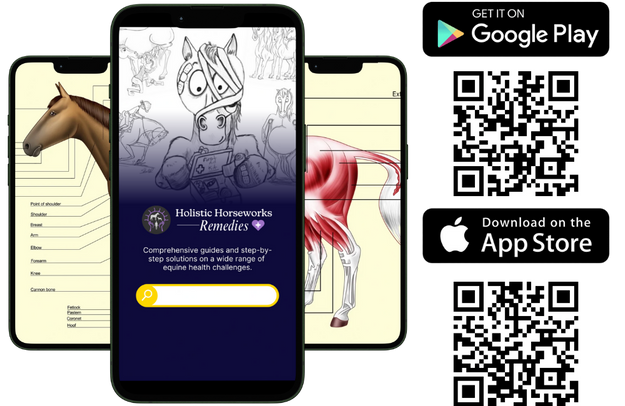Prevent Uveitis in Horses for Healthier Eyes
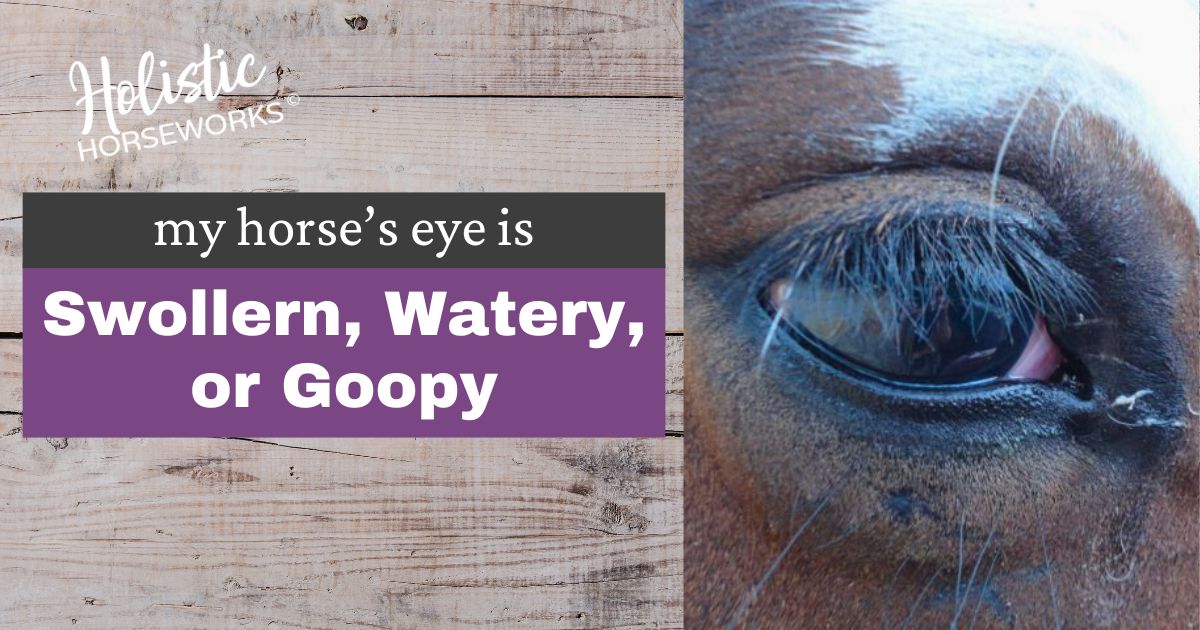
Share This Post:
Do you notice swelling above or below your horse’s eye? Is the inside corner inflamed and pink, or is the eye constantly tearing up? Maybe there’s a weird discharge? These are telltale signs of equine uveitis, or, more simply said, inflammation of the eye.
If your vet has diagnosed your horse with uveitis, you might be offered traditional treatments like prescription eye medication or surgery. But don’t let this diagnosis make you feel helpless! With our simple, hands-on horse bodywork techniques, you can learn to prevent and improve this condition yourself. Not only will you be helping your beloved horse, but you’ll also save lots of money on repeated vet visits!
Remember, the best thing you can do is to try. The worst thing you can do is nothing!
Understanding Equine Uveitis
Equine uveitis is an inflammatory menace that targets the uvea, the middle layer of your horse’s eye. Left untreated, it can cause severe discomfort, poor vision, and even complete vision loss. As a horse owner, understanding the causes, symptoms, strategies for prevention, and treatment options is essential to safeguarding your horse’s vision and health.
Symptoms of Equine Uveitis
Equine uveitis can present a range of symptoms, from mild discomfort to severe vision impairment. Keep an eye out for these telltale signs:
- Eye Pain: Look for signs of discomfort, such as squinting, tearing, excessive blinking, or attempting to rub the eye.
- Redness and Swelling: Inflammation in the affected eye can cause the conjunctiva’s redness and eyelids’ swelling.
- Discharge: Eye discharge can vary in color and consistency. Sometimes, it may be thick and sticky, causing the eyelids to stick together.
- Cloudiness: The cornea or the inside of the eye may appear cloudy due to inflammation.
- Sensitivity to Light: Your horse may react to or avoid bright light, indicating photophobia.
- Vision Changes: In severe cases, you might notice impaired vision or even signs of blindness.
Here’s something else to watch out for: If your horse has uveitis, they may start rubbing their head on their foreleg to scratch the eye and relieve irritation or discomfort. But as your horse rubs their eye, they may get fly spray or other chemicals in it, leading to even more inflammation and pain. This creates a vicious cycle of increasing discomfort and worsening symptoms.
An official diagnosis can only be made by a veterinarian, but you may notice these symptoms as indicators of uveitis in your horse. Officially diagnosing uveitis typically involves a combination of physical and ophthalmic examinations, lab work, and possibly ultrasound imaging
What Causes Equine Uveitis?
Traditional veterinary medicine identifies several factors that can lead to the development of uveitis in horses. Here are some common contributors:
- Infectious Agents: Bacterial, viral, or parasitic infections can trigger an immune response that leads to uveitis. A notable example is leptospirosis, a bacterial infection that often causes this condition.
- Trauma: Physical injury to the eye can result in inflammation and subsequent uveitis.
- Genetics: Some horse breeds, like Appaloosas, are genetically predisposed to developing uveitis.
While conventional veterinary medicine cites these causes of uveitis, we often find that head trauma is a significant, yet overlooked, culprit.
Head trauma usually happens when a horse pulls back while tied. But why would this lead to weepy, inflamed, and red eyes? Good question!
We’ve all seen it: your horse is tied to a rail or trailer, something startles them, and they suddenly pull back in a panic. Their “fight or flight” response kicks in, and before you know it, the horse is reacting instinctively, trying to flee from the perceived danger and struggling to get free from whatever they are tied to.
As the panic escalates, the horse pulls against the tie, causing the halter to pull down on the occiput (the knobby part at the top of the skull). This pulls the occipital area down and forward, creating compression and flattening the area.
As the horse pulls harder, it can twist its head to one side, resulting in uneven pressure and more compression on one side of the skull. This intense pressure affects all the cranial and facial bones: the occipital, parietal, frontal, nasal, temporal, and especially the lacrimal (cheekbone).
When the lacrimal bone is compressed, it jams and obstructs the lacrimal duct (tear duct), preventing proper drainage. This leads to a clogged duct, causing swelling above and below the eye, discharge, and redness: uveitis.
Looking at the issue from a whole-body perspective, we can understand how cranial compression could be a common cause of uveitis.
Symptoms of Head Trauma in Combination with Uveitis
Very often uveitis goes hand-in-hand with head trauma. Is your horse experiencing any of these other problems simultaneously as uveitis?
- Frequent spooking
- Head-shaking
- Struggling to turn smoothly
- Resisting the halter or bridle
- Difficult to bit
These behaviors can be more than just quirks—they might be symptoms of head trauma which can lead to uveitis as a result!
Preventing or Recovering From Equine Uveitis and Head Trauma
Traditional treatment for uveitis can range from the use of anti-inflammatory medications, antibiotics or antifungals, Atropine, or, in severe cases, surgery.
If your horse is being prescribed eye medication, here is a video on how to administer the eye medication easily.
At Holistic Horseworks, our alternative, holistic whole-body approach to horse care shows you address the root cause of uveitis— cranial compression— rather than focusing solely on the symptoms. Learning this approach may help your horse recover from or prevent this condition.
In the photo below, this five-year-old horse was diagnosed with uveitis and scheduled to have its eye surgically removed. Before a session, the eye was puffy, swollen, weepy, and red. After just one hour of bodywork, the eye vastly improved. During the next vet exam, the vet no longer recommended removing the eye!
Want to get these results? We’ll show you how!
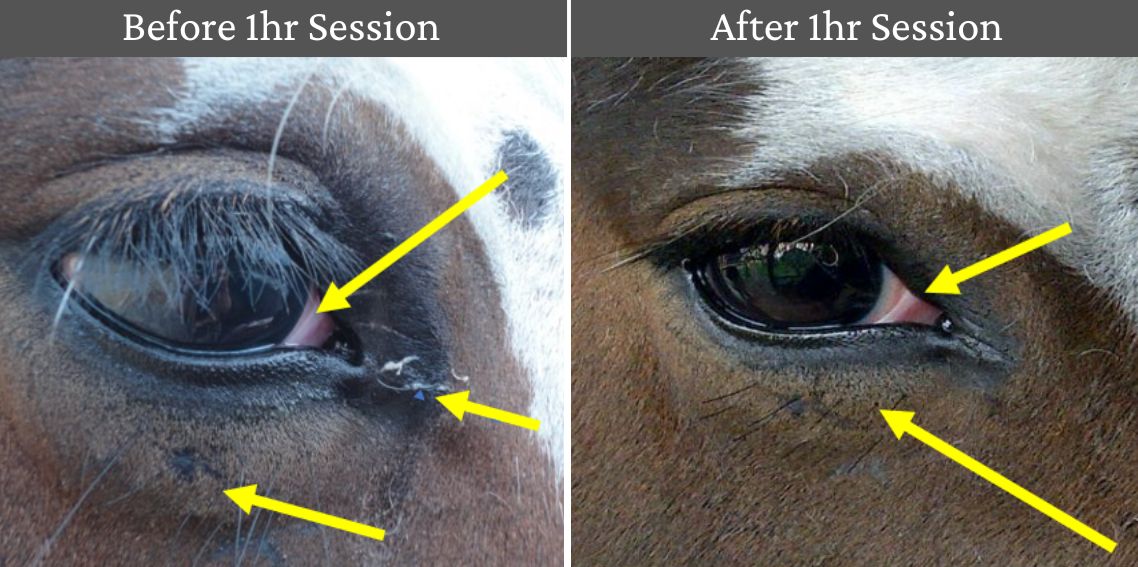
Equine Cranial Decompression
 Equine Cranial Decompression is a technique that manually repositions misaligned bones in the horse’s skull.
Equine Cranial Decompression is a technique that manually repositions misaligned bones in the horse’s skull.
Through manual manipulation of bones like the lacrimal bone near the eye,we have seen many horses find relief from chronic and acute uveitis.
Because it requires sensitive manual manipulation of the cranial bones, Equine Cranial Decompression is only available to learn in person at a hands-on clinic. This is level 3 of the Holistic Horseworks Program, and the final step in releasing the horse’s skull and restoring their entire body to proper balance, form, and function. Enrollment requires completion of Level 1: Equine Musculoskeletal Unwinding andLevel 2: Cranio Sacral Unwinding and Advanced Applied Kinesiology.
Dynamite Release Spray
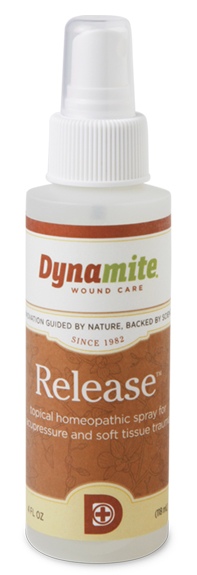 One helpful tool for addressing uveitis and cranial issues in horses through Cranial Sacral or Cranial Decompression therapy is Dynamite’s Release spray. This spray helps open up blood flow and get things moving when working on a horse’s cranial bones and structures.
One helpful tool for addressing uveitis and cranial issues in horses through Cranial Sacral or Cranial Decompression therapy is Dynamite’s Release spray. This spray helps open up blood flow and get things moving when working on a horse’s cranial bones and structures.
Apply the Release spray liberally over the horse’s head. The spray helps open things up and prepare the area for manual adjustments to the cranial bones. Using the Release spray can help speed up the results when doing cranial sacral work on a horse. By improving blood flow and circulation to the head, the spray supports the healing and rebalancing of the cranial structures.
Dynamite’s Release spray is an all-natural, topical product that combines flower essences and other natural ingredients to ‘release’ areas of the body experiencing inflammation, swelling, pain, etc.
With Holistic Horseworks programs, you’ll learn how to ease all those pesky pains and restrictions from head to tail that can lead to uveitis and a bunch of other horse health issues. Our methods are gentle, easy to pick up, and super effective. They’ll help your horse bounce back with more energy, flexibility, and top-notch performance skills, turning them into the happy, healthy equine partner you’ve always wanted
🍎 Ready to Start Helping Your Horse?
Start with April’s foundational training, Equine Musculoskeletal Unwinding, available to learn online with live 1:1 support.
This step-by-step course teaches you how to release deep patterns of imbalance and pain—so your horse can move, feel, and live better.
Includes video lessons, downloadable workbooks, and a personalized distance reading from April herself.
Rather learn in-person?
Check out our hands-on equine remedial therapy clinics, available all over the globe →
More Holistic Horse Care Education
6 Must-Know Hore Care Tips for Winter
In this comprehensive guide, we'll share five essential cold weather horse care tips straight from the experts at Holistic Horseworks.Whether you're dealing with freezing
Equine Vaccines: What’s In Them and How to Help Your Horse Naturally
Vaccines are often considered a cornerstone of equine health, but have you ever wondered exactly what’s in them, or how they might be affecting
Barn Life Tips for a Bug Free Summer
Every season, I hear from folks battling mosquitoes, flies, and ticks in the barn, garden, and pasture. Over the years, I’ve found a few
Horses Are Talking, Are You Listening?
Holistic equine expert April Love wants you to know: your horse is speaking. And once you learn how to listen, everything changes. In her
How a Distance Reading CHANGED Kimberly and Her Horse
In this interview, holistic healing expert April Love uncovers the deep, often invisible threads connecting horse and human wellness. Join Kimberly, host of The
Summer Travel Tips for Your Horse: Keep Them Happy, Healthy, & Hydrated
Traveling to summer shows and events can be exciting, but for our horses, it often comes with a heavy load of emotional and physical
Mud Fever Prevention and Remedies
Mud fever, also known as pastern dermatitis, scratches, grease heel, etc., is a common skin condition in horses caused by a combination of wet
Is It Really a Training Problem, or Is Your Horse in Pain?
If your horse bucks, resists the canter, or just feels off under saddle, the first thing many people assume is that it’s a training
Did You Know That Saddle Fit Issues Are Really Horse Body Issues?
Saddle fit isn’t just about the saddle — it’s about the ever-changing body of the horse beneath it. While it’s tempting to invest in
Useful, Helpful Tips and Tricks for Horse Care | April Love’s Interview on The Backyard Horse Enthusiast
What would you do if your horse was limping, colicking, or spooking—and no one could tell you why? That question lit a fire in
Sign Up for Our Newsletter

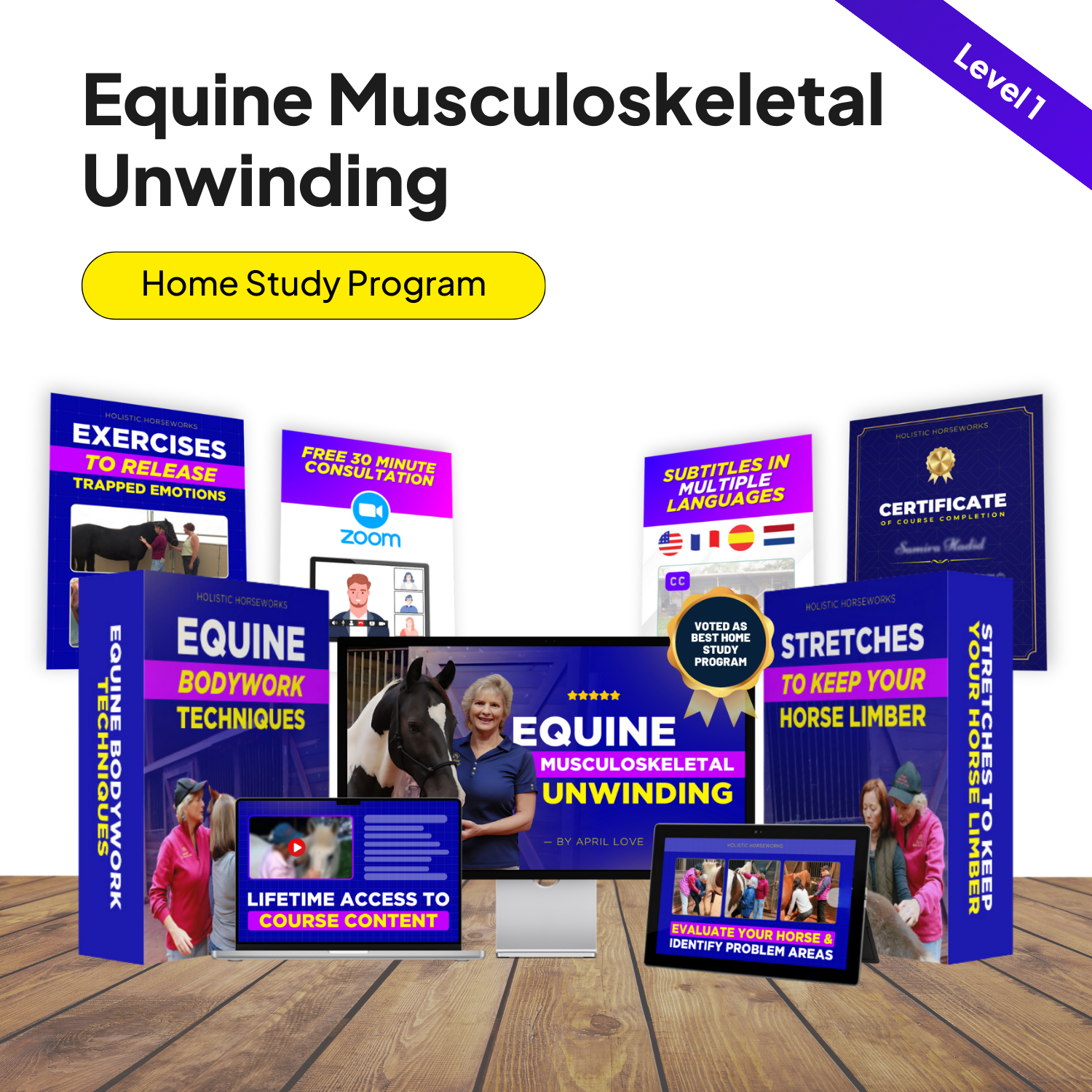

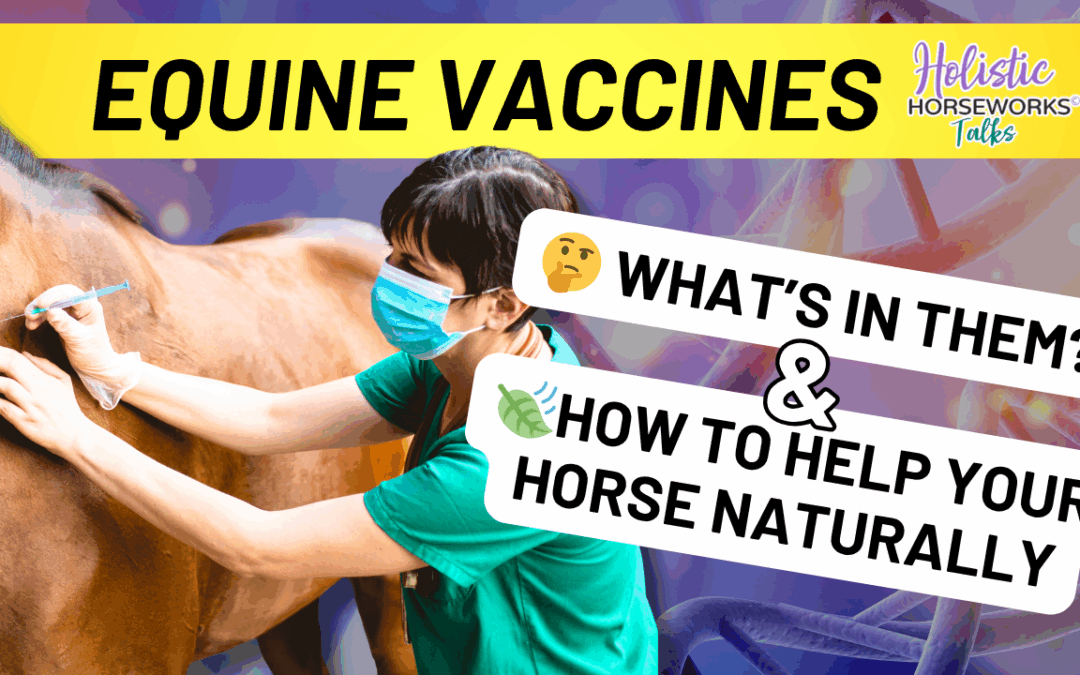

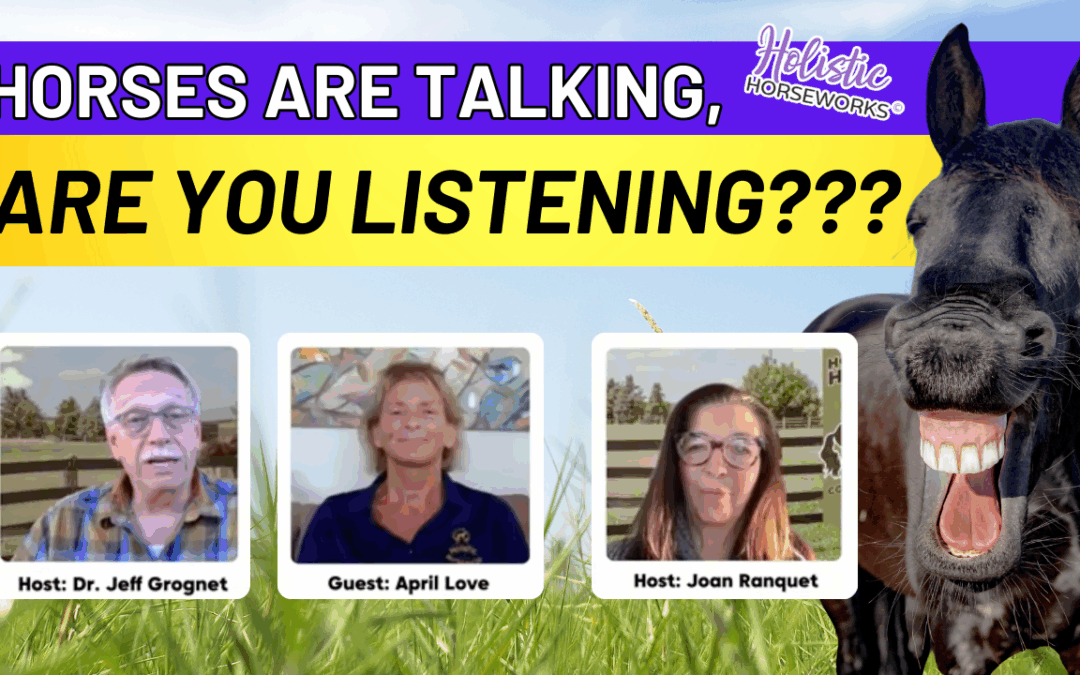
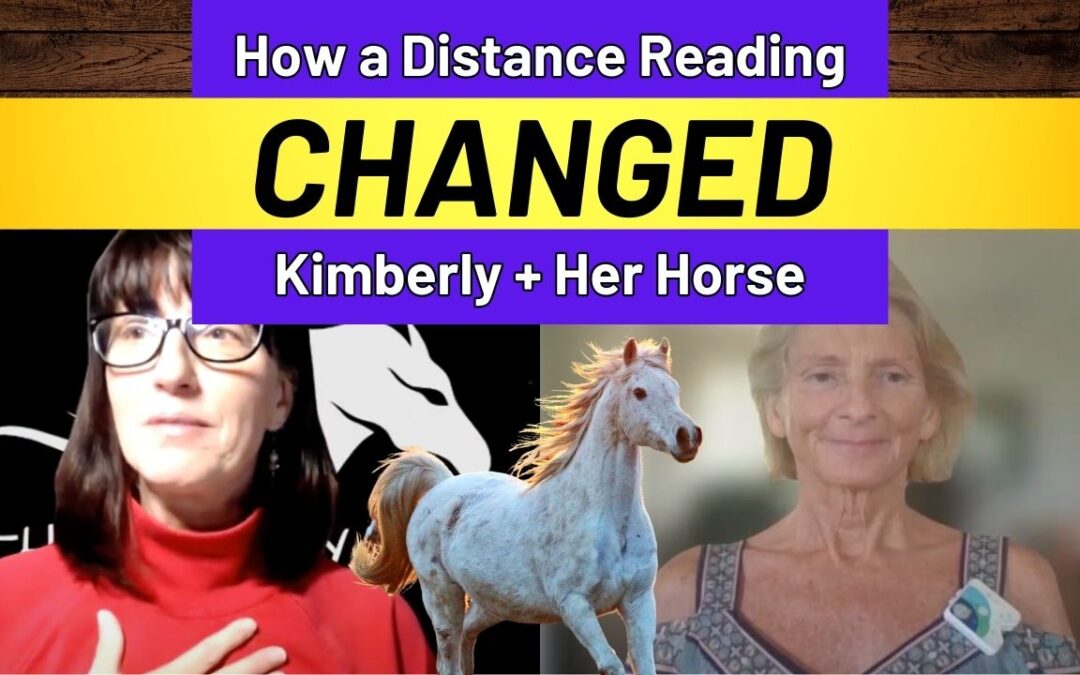


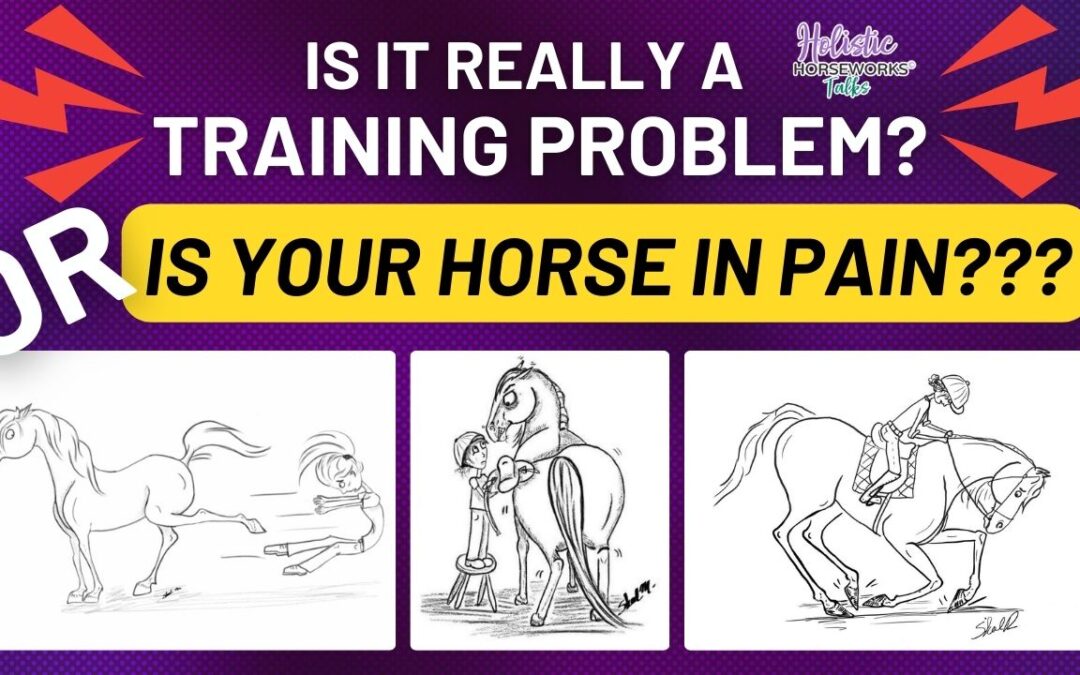

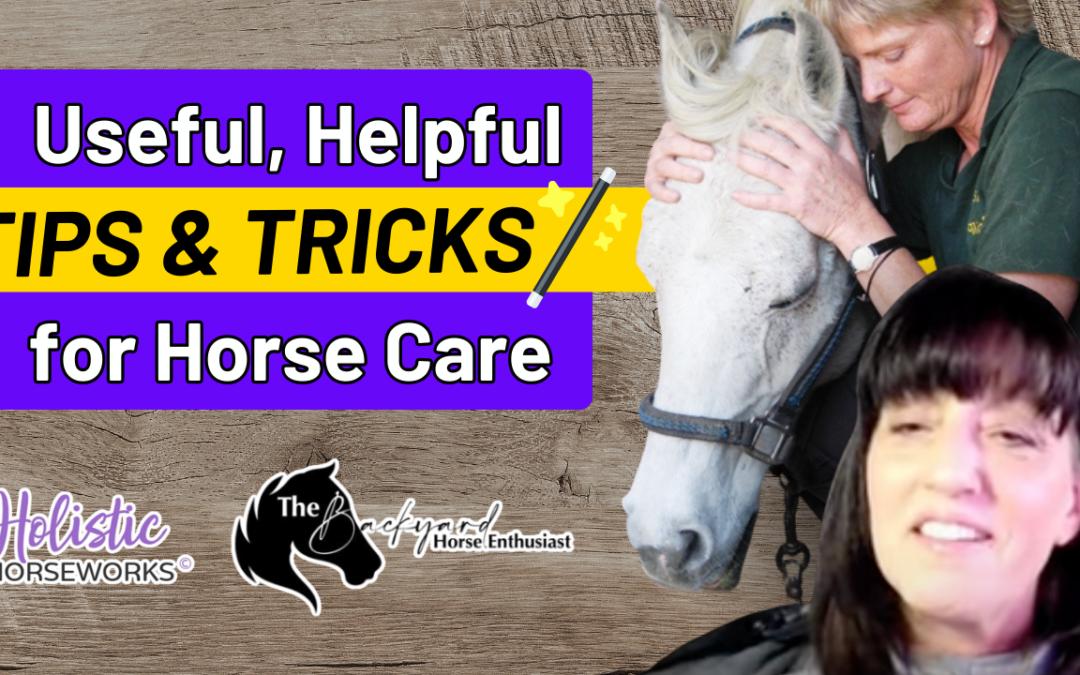

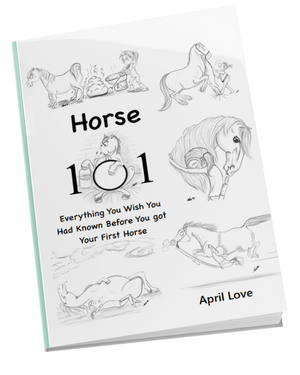
![Complete Level 1 & Level 2 Home Study + Private Training Package [NO DVD]](https://holistichorseworks.com/wp-content/uploads/2022/08/Level-1-and-Level-2-complete-home-study-and-training-package-400x400.jpg)
![Level 1 "Equine Musculoskeletal Unwinding" Home Study -Watch Instantly [NO DVD]](https://holistichorseworks.com/wp-content/uploads/2022/08/Level-1-Home-Study-400x400.jpg)
![Level 2 “CranioSacral Unwinding & Advanced Applied Kinesiology” Home Study - Watch Instantly [NO DVD]](https://holistichorseworks.com/wp-content/uploads/2022/08/Level-2-Home-Study-400x400.jpg)

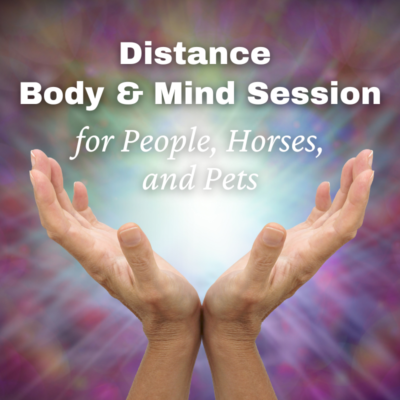
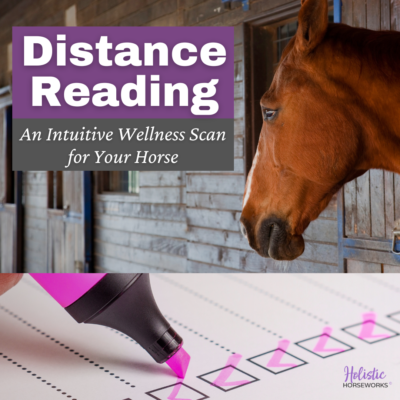
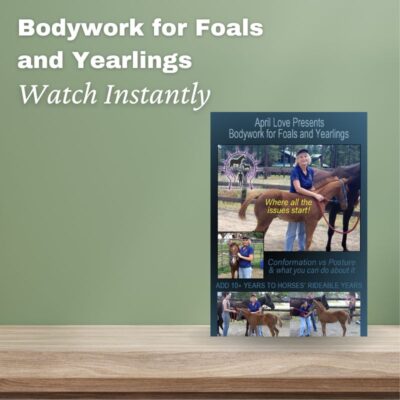
![Equine CranioSacral Energy Work -Watch Instantly [English and French]](https://holistichorseworks.com/wp-content/uploads/2022/09/equine-cranial-sacral-energy-work-watch-instantly-400x400.jpg)
